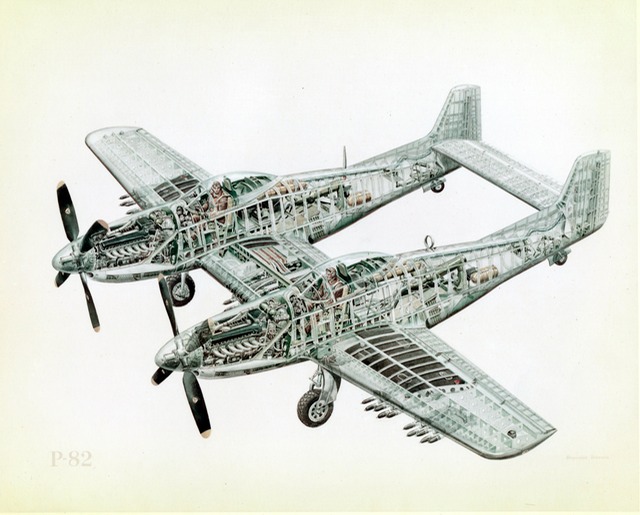The Origin of the XP-82
By Lowell F. Ford

It was late in 1939, NAA was a beehive of activity as events in Europe began to overheat. As James H. Kindelberger walked past Chief Designer Edgar Shmued’s drafting table he noticed a design he had not been aware of or authorized. It was a low wing twin fuselage airplane designed around two Ranger air cooled engines. Kindelberger approached Schmued regarding the design and strongly suggested that unless he wanted to seek new employment, he should remove the twin fuselage design from his board and stick with approved projects at hand.
Ed followed the advice of his boss and took the drawing home with him where he allotted time to improve the design as best he could. The demands of the wartime effort weighed heavily on any spare time to be devoted to his pet twin fuselage project. It seemed that the design would never find an opening for use in aviation history.
When the B-29 entered into service as the long range bomber to subdue the Japanese industrial might, the only fighter escort available that could endure the extended range flights from Tinian to the target areas and back was the P-51 Mustang. Until bases could be secured on islands closer to the targets, the P-51 escorts range limits were being severely stretched to insure safe return to their base. Both aircraft, the B-29’s and the P-51’s were suffering from the wear and tear on the equipment and crew fatigue due to these missions.

As the war in Europe began to swing in favor of the Allies, some heads of state grew increasingly skeptical of Stalin’s intentions and the potential for long range missions against targets deep into Russia became a predicted requirement in military planning. A long range escort to support these over the Pole missions became more apparent. Soon the War Room at NAA began to hum with ideas of what would be needed to meet a requirement for an escort to keep pace with the bombers.
As with the initial design of the Mustang, Ed Schmued dusted off his preliminary design drawings on the twin fuselage airplane he had been scolded for working on illegally and revised it to incorporate two of the Packard Merlin power plants that had carried the Mustang to fame in the European Air War. The new design was dubbed the XP-82 Twin Mustang, as it incorporated many of the proven features of its single engine namesake to insure the best possible performance.
As events unfolded, the NAA design was chosen for the long range escort contract and Edgar Schmued was celebrating his long time ambition of a twin fuselage airplane being in production. To demonstrate its long range capabilities, the P-82 “Betty JO” flew from Honolulu, Hawaii to New York City, N. Y. non-stop in 14 hours and 32 minutes. This record is unbeaten to this day by a propeller driven aircraft.
